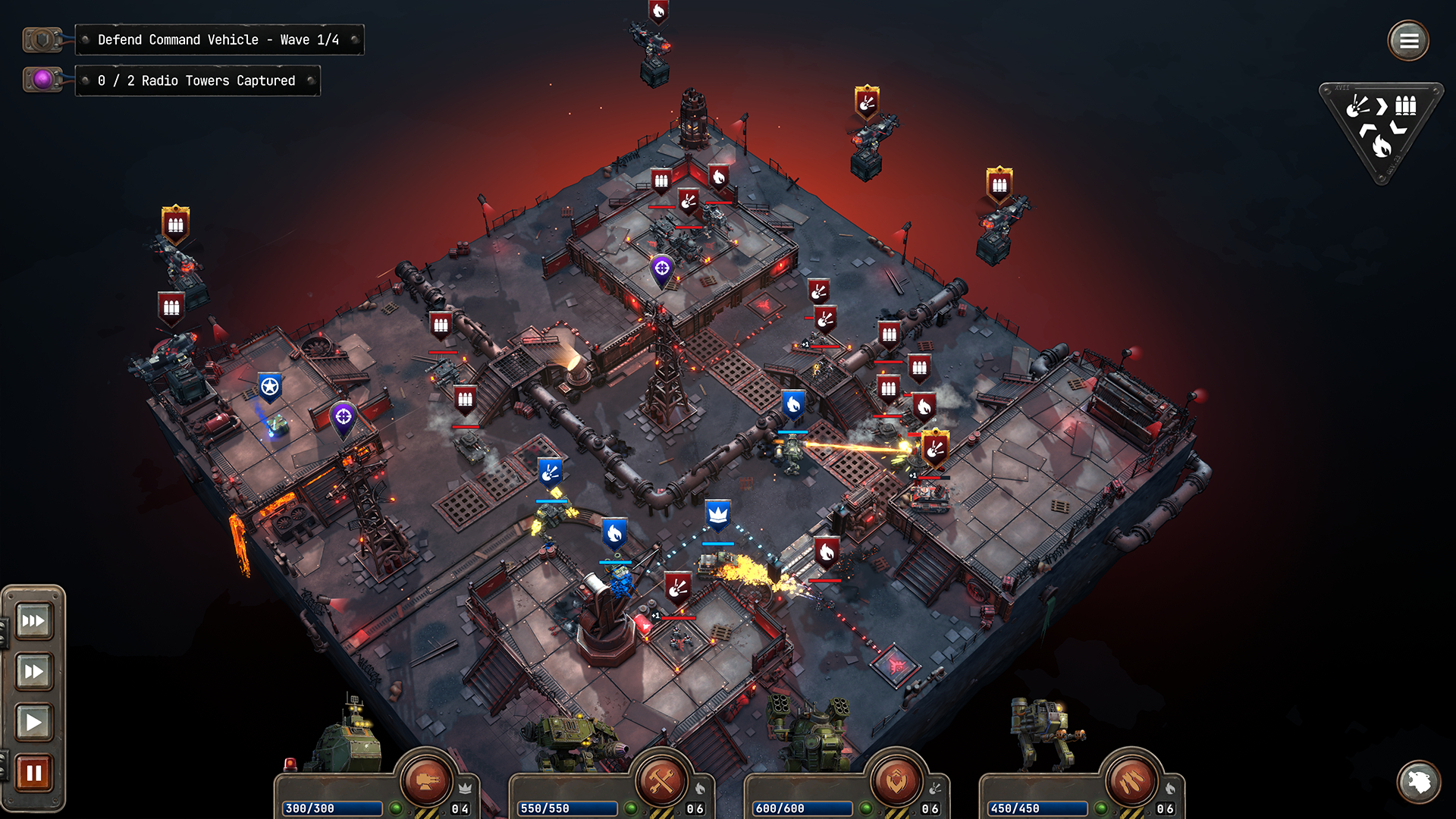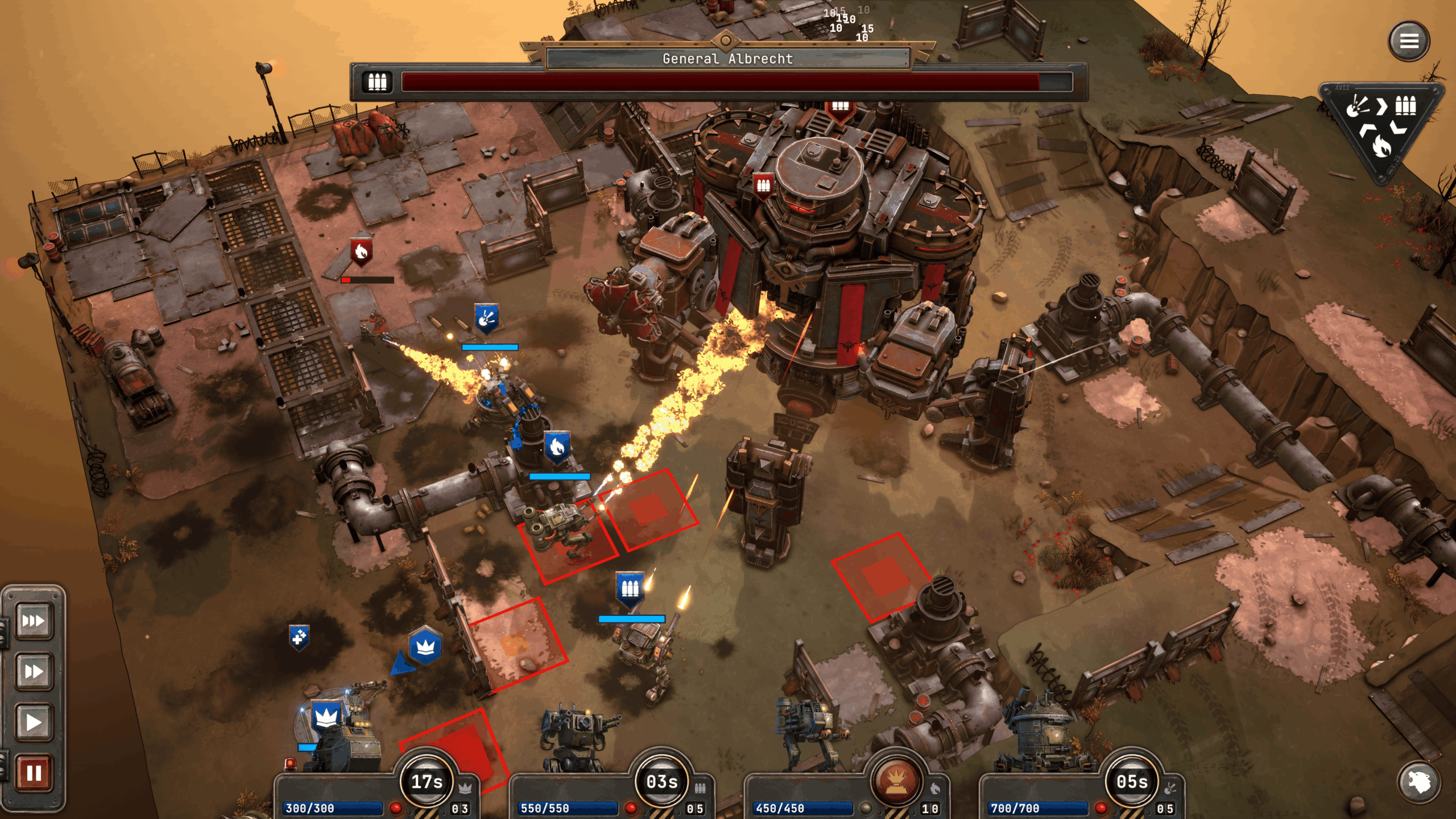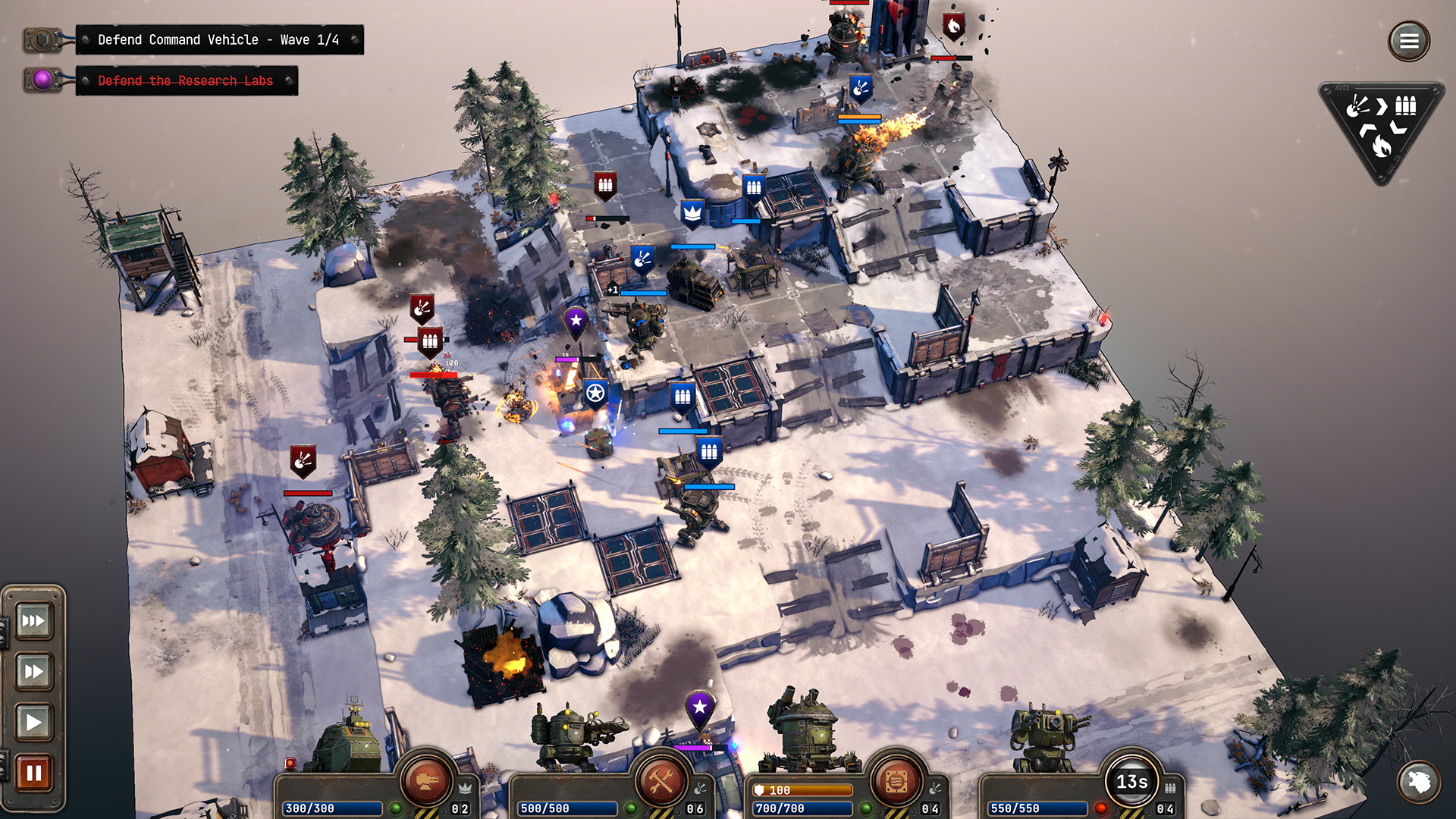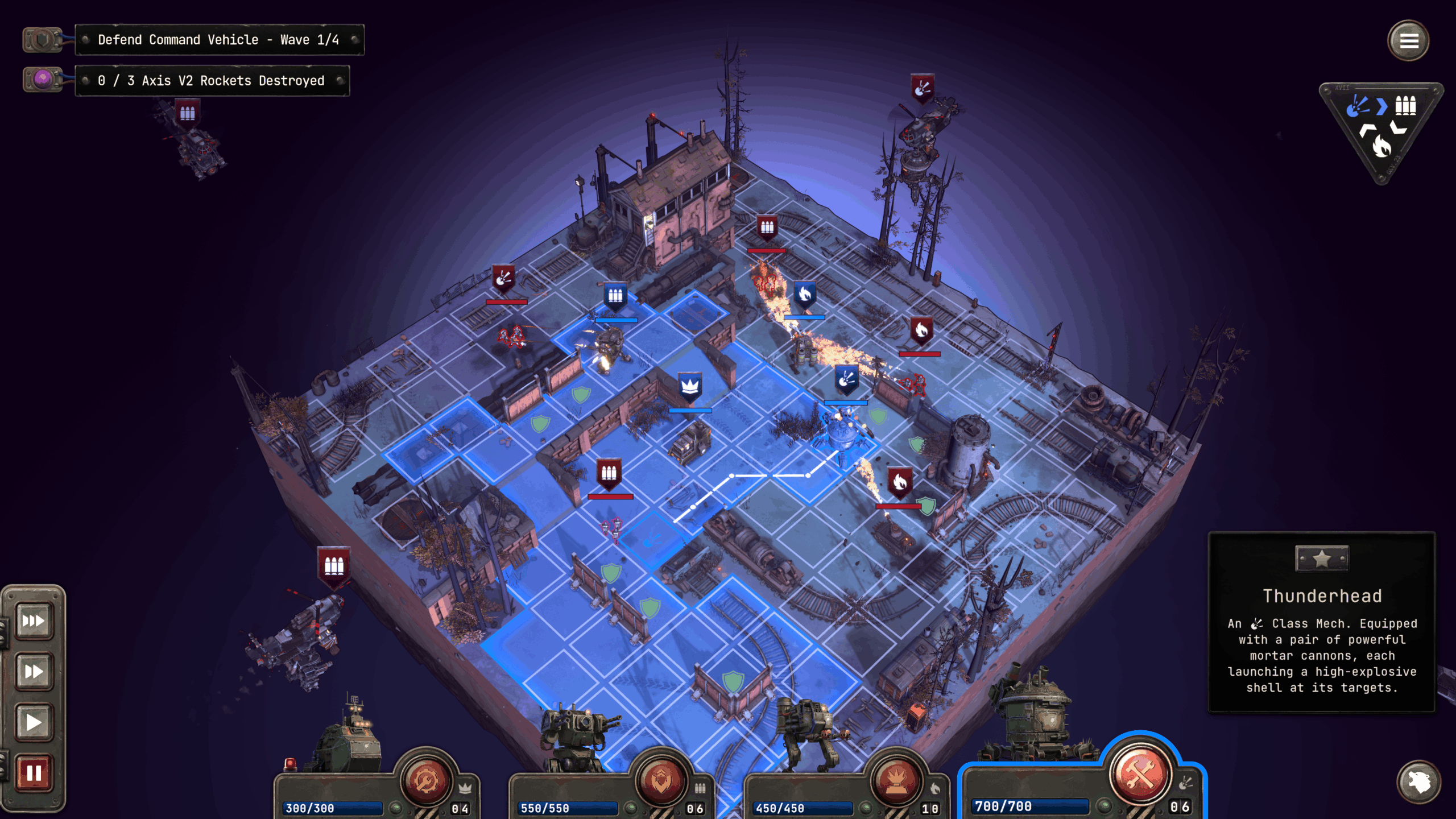Alternate histories and giant mechanical behemoths go hand-in-hand like cheese and marmite. Starting off strong with that comparison (yes, I love cheese and marmite, I’ll die on this hill). Grit and Valor – 1949 takes the Wolfenstein approach of reimagining the outcome of World War Two, where instead of the allies marching out triumphant, German forces seized all of the UK and Europe with mechanized might.
As the resistance, based on the last remaining bastion of defiance in the Scottish isles, it’s your job as commander-in-chief to take back liberty. I love mechs as much as the next guy, so does Grit and Valor – 1949 create a strategy game on par with the action of Armoured Core, or see its steel chassis rust away in the annals of obscurity?
Gritiful Defence
Having made that Wolfenstein reference, I should clarify that Grit and Valor – 1949 is not an in-depth alternative history story. Rather, it’s window dressing for the rogue-like gameplay. Regions have different colour palettes and details reflecting their climates, while you can expect a small amount of expositional dialogue during your runs. Aside from that, there’s very little on offer here in terms of overarching story to drive things along. Axis forces are the dominant bad guys, you’re the good guys, get out there and save the world.
I was underwhelmed by the lack of real development of the world and atmosphere. The initial impression is engaging, as it mixes 1940s military aesthetics with futuristic steel weapons and unrelenting warfare. Unfortunately, I never felt Grit and Valor – 1949 really takes that premise beyond surface level visuals. Exchanges between your officer and the enemy generals come off flat, often being repeated after the a couple of instances.
It’s sadly forgettable. I wasn’t expecting a huge amount – this is an indie, rogue-like title after all, but even the little that is here feels under utilised. The opposing generals are comically basic too, coming off more as cartoon villains than anything actually interesting. While not offensive, the storytelling is Grit and Valor 1949’s weakest aspect and felt like a missed opportunity.

It’s Over Mech-Anakin
Let’s make like a Spitfire and get into the action. Grit and Valor – 1949 is a small-scale real-time strategy game encapsulated in a rogue-like design, with mechs, obviously. You’ll embark on a mission to liberate one of four regions, fighting through multiple battles to reach the final confrontation with a general. Lose your command vehicle or your defending mechs, you’ll be sent scarpering back to home base like a machine with no electrics.
Each encounter features four waves of enemies being dropped from a direction, with height, positioning and cover being king (of the hill). Placing your mechs on elevated plains means they do bonus damage and are harder to hit. Finding your machines looking up at opposing forces is a death sentence. Similarly, cover will completely negate all damage for whomever is behind it, but only until it is destroyed. The maps are small-scale and you’ll very quickly become acquainted with taking the high ground like Obi-Wan, if he had a minigun and shoulder mounted rockets. That would have made for a very different movie…
Additionally, each mission will feature a sub-objective for a small reward of upgrade currency (more on that later). Defend civilian tents, destroy enemy rockets, deliver fuel, the usual grunt work. In theory, this should create a constant push-and-pull of taking optimal positions, while taking risks to maximise your rewards from each engagement. Once again however, Grit and Valor – 1949 quickly falls victim to a lack of real tactical opportunity and an overreliance on meta-progression.

Rock, Paper, Missiles
See, while there’s a rock-paper-scissors style to the three unit types you command and face, there’s no real variation to them outside of this. After your first couple of runs, you’ll have seen almost everything Grit and Valor has in the tank to throw at you. Most engagements boil down to picking the highest point on the map, or sticking your mechs behind walls. Equally, there’s no reason at all to pick mechs with shorter range, as the game is so defensively orientated.
I had a lot of initial fun tinkering with the abilities (mines, jump jet, airstrike etc) and trying to outwit the AI. That was, until I realised that the optimal strategy is to hunker down on a hill and just hope my units out damage theirs. There’s often beauty in simplicity, but Grit and Valor – 1949 could have done with a bit more depth on this front. Boss battles do mix things up somewhat, but they come after a long slog of a campaign, so their ingenuity is diminished by this somewhat.
That being said, all of your hard fought battles will typically end in destruction for your mechs or the opposing general. When the endgame is reached, you’ll be whisked back to your home base, which features three upgrade paths for permanent progression. The hub itself is nothing to write home about, but it serves its purpose and the idle animations floating around it are a nice touch.

A Gritty Finish
Remember the meta progression I mentioned earlier? Well, you should, because Grit and Valor – 1949’s gameplay loop rests a helluva lot of its weight upon it. In-run temporary boosts are often basic stat improvements and won’t fundamentally shift the tide of a campaign. As such, you’ll accrue Valor for pilot upgrades (your special abilities), blueprints for new mech types and modules for your units equipment slots.
Effectively, each run is a throwaway attempt to gain more of these currencies or items, to improve your units stats or unlock better variants of mech. It’s all very static – modules improve damage output, resistance and speed, Valor boosts the effectiveness of abilities. There’s very little dynamic interchange going on, which the best rogue-likes thrive upon. There’s no option to really throw caution to the wind with a crazily over-powered glass cannon of a mech, or have a Steelhawk that can boost its range at the expense of snail like speed, for example.
It all culminates in a progression system that feels stifling until you’ve simply died enough to have a fighting chance at victory. Instead of learning accompanying the meta progression, or adapting to weird and wonderful builds, you’re just playing to get enough upgrades to out damage the enemy. That was certainly fun for the first few hours, but became tiresome by the time I hit the third region. Grit and Valor 1949 has some really solid foundations, but it relies too heavily on static advancement that it stifles creative or adaptive play.

No More Unto The Breach
I really do want to emphasise that Grit and Valor – 1949 is not a bad game. On the contrary, I think it’s fairly decent. I dig the atmosphere and alternate history setting. I enjoyed the simplistic but satisfying rock-paper-scissors format. Plus, it has mechs, and mechs are just cool. For the first few hours, it makes a good impression and flatters to deceive for a chunk of its runtime.
However, once the initial excitement and intrigue fell away, I was left wishing there was more to it. It’s like if a car had a Ferrari exterior, only for you to open the door and discover it’s a Fiat Punto in engine and interior. It’ll absolutely do the job and has the basic underlying mechanics to serve its purpose as a rogue-like, but it doesn’t have the flair that makes the best of the genre pop.
I enjoyed my half a dozen hours with Grit and Valor – 1949 for what they were, but I can’t say it’s one that’ll stick in the mind. If you like the setting and concept, you’ll find some satisfaction in seeing hulking steel frames explode. After the adrenaline rush subsides and you’re left to rue the wreckage however, you may find yourself feeling somewhat detached and underwhelmed.
Grit and Valor – 1949 is available now on PC via Steam (review platform).
Developer: Milky Tea Studios
Publisher: Megabit Publishing
Disclaimer: In order to complete this review, we were provided with a promotional copy of the game. For our full review policy, please go here.
If you enjoyed this article or any more of our content, please consider our Patreon.
Make sure to follow Finger Guns on our social channels –Twitter, Facebook, Twitch, Spotify or Apple Podcasts – to keep up to date on our news, reviews and features.
